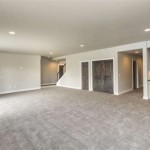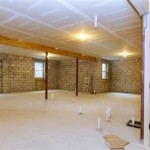Painting My Basement Ceiling Black: A Comprehensive Guide
Painting a basement ceiling black is a design choice that has gained considerable popularity in recent years. Once relegated to commercial spaces like theaters and restaurants, black ceilings are now finding their way into residential homes, particularly in basements. This article aims to provide a comprehensive exploration of the factors to consider when undertaking such a project, detailing the preparation, materials, application techniques, and potential benefits and drawbacks.
The visual impact of a black ceiling is often described as transformative. It can create an illusion of greater height, effectively making the ceiling "disappear." This is particularly appealing in basements, which are often characterized by low ceilings. Furthermore, a black ceiling can contribute to a more modern and sophisticated aesthetic, providing a dramatic backdrop for lighting fixtures and other design elements. The decision to paint a basement ceiling black, however, should be carefully considered, taking into account the specific characteristics of the space and the desired outcome.
Assessing the Existing Conditions
Before embarking on any painting project, a thorough assessment of the existing conditions is crucial. In the case of a basement ceiling, this involves several key steps. First, inspect the ceiling for any signs of water damage, mold, or structural issues. Addressing these problems is paramount before applying any paint. Water leaks need to be repaired, and mold, if present, must be properly remediated. Ignoring these issues will only result in further damage and potential health hazards.
Next, determine the type of ceiling that is present. Is it a drywall ceiling, an exposed joist ceiling, or a drop ceiling? Each type requires a different approach to surface preparation and paint application. Drywall ceilings are generally the easiest to paint, while exposed joist ceilings require more detailed work to ensure complete coverage. Drop ceilings, with their individual tiles, may be best addressed by removing and painting the tiles separately or replacing them altogether with black tiles.
Finally, consider the lighting conditions in the basement. Black ceilings absorb light, so it is essential to ensure that the space has adequate artificial lighting. If the basement relies heavily on natural light, painting the ceiling black may significantly darken the room. In such cases, careful planning of lighting placement and fixture selection is crucial to maintain a comfortable and functional environment.
Materials and Tools Required
The selection of appropriate materials and tools is essential for achieving a professional and long-lasting finish. Choosing the right paint is particularly important. For most basement ceilings, a flat or matte black paint is recommended. These sheens minimize light reflection and create a more uniform and "invisible" effect. Avoid using gloss or semi-gloss paints, as they will highlight imperfections and reflect light, defeating the purpose of a black ceiling. Consider using a paint specifically formulated for ceilings, as these paints tend to be thicker and less prone to dripping.
In addition to paint, the following materials and tools will be necessary: painter’s tape, drop cloths or plastic sheeting, a good quality paint roller (with extension pole), paint brushes (various sizes for detail work), paint tray, primer (if necessary), joint compound and putty knife (for patching holes), sandpaper (for smoothing surfaces), a ladder or scaffolding (for reaching high ceilings), and safety glasses and a dust mask. Preparing the space adequately with drop cloths and painter's tape protects surrounding areas from paint splatters and ensures clean lines.
The choice of primer depends on the condition of the ceiling. If the ceiling is new drywall or has been previously painted, a general-purpose primer is sufficient. However, if the ceiling has stains or discoloration, a stain-blocking primer is recommended. Primer creates a uniform surface for the paint to adhere to, improving coverage and preventing the underlying color from bleeding through. Furthermore, a primer can improve the durability of the paint finish.
The Painting Process: Step-by-Step
The painting process itself involves several stages, each requiring careful attention to detail. The first step is surface preparation. This involves cleaning the ceiling to remove dust, dirt, and cobwebs. Use a vacuum cleaner with a brush attachment or a damp cloth to thoroughly clean the surface. Next, inspect the ceiling for any holes or cracks and fill them with joint compound. Allow the joint compound to dry completely and then sand it smooth with fine-grit sandpaper. This ensures a smooth and even surface for painting.
Once the surface is prepared, apply painter’s tape to the edges of the ceiling where it meets the walls. This will create a clean and crisp line. Cover the floor and any furniture with drop cloths or plastic sheeting to protect them from paint splatters. Now, apply the primer, if necessary. Use a roller to cover the majority of the surface, and use a brush to paint the edges and corners. Allow the primer to dry completely according to the manufacturer’s instructions.
After the primer has dried, it is time to apply the black paint. Pour the paint into a paint tray and load the roller with paint. Apply the paint in even strokes, overlapping each stroke slightly. Start in one corner of the room and work your way across the ceiling. Use a brush to paint the edges and corners. Allow the first coat of paint to dry completely before applying a second coat. Two coats of paint are usually necessary to achieve full coverage and a uniform color. Once the second coat has dried, carefully remove the painter’s tape. Inspect the ceiling for any imperfections and touch them up with a brush if necessary.
Considerations for Exposed Joist Ceilings
Painting an exposed joist ceiling black presents unique challenges compared to a drywall ceiling. The increased surface area and intricate structure require a more meticulous approach. Thorough preparation is even more critical to ensure a professional-looking result. Careful cleaning to remove accumulated dust and debris within the joists is essential.
When painting exposed joists, a combination of brushes and rollers is typically required. A small to medium-sized brush is ideal for reaching into the corners and crevices between the joists and the subfloor. A roller with a shorter nap can be used to cover the broader surfaces of the joists. Multiple coats are often necessary to achieve complete and even coverage, especially in areas where the wood grain is more pronounced.
The type of paint used is also an important consideration. While flat or matte black paint is still generally preferred for its light-absorbing properties, it's crucial to select a paint formulated for wood. This will ensure proper adhesion and prevent the paint from peeling or cracking over time. Proper ventilation is crucial when painting exposed joists, as the fumes from the paint can accumulate in the confined space.
Addressing Potential Drawbacks
While a black ceiling can offer significant aesthetic benefits, it's important to acknowledge potential drawbacks. As previously mentioned, black absorbs light, which can make a basement feel darker and smaller if not properly addressed with adequate lighting. Consider incorporating multiple light sources, such as recessed lighting, track lighting, and lamps, to compensate for the light absorption.
Another potential issue is the visibility of imperfections. While flat or matte paint helps to minimize light reflection, any imperfections in the ceiling, such as uneven surfaces or poorly patched holes, may still be noticeable. Careful surface preparation is essential to mitigate this issue. Taking extra time to sand and smooth the ceiling before painting will result in a smoother and more professional-looking finish.
Finally, consider the long-term maintenance of a black ceiling. Dust and cobwebs can be more visible on a dark surface than on a light one. Regular cleaning with a vacuum cleaner or a damp cloth is necessary to maintain a clean and well-maintained appearance. Moreover, any scratches or scuffs on the black paint will be more noticeable and may require touch-ups.
Alternative Design Considerations
Before committing to a completely black ceiling, explore alternative design options that can achieve similar effects with less significant drawbacks. For example, consider painting only a portion of the ceiling black, such as the area above a specific feature like a bar or entertainment center. This can create a focal point and add visual interest without darkening the entire space.
Another option is to use a dark gray or charcoal color instead of pure black. These shades still offer a dramatic effect but are slightly less light-absorbent. They can also be easier to coordinate with other colors in the room. Furthermore, explore the use of textured paints or decorative finishes to add depth and dimension to the ceiling. These techniques can create a unique and visually appealing look.
Ultimately, the decision of whether or not to paint a basement ceiling black is a personal one. By carefully considering the specific characteristics of the space, the desired aesthetic, and the potential drawbacks, it is possible to make an informed decision that will result in a beautiful and functional basement environment.

Our Painted Basement Ceiling Black With Photo Examples

Basement Ceilings Painted Black A Spray Painting Job From Hell

Our Painted Basement Ceiling Without A Sprayer And The Perfect Black Paint This Diy Life

Black Painted Ceiling Vs White In Michigan Basements

Our Painted Basement Ceiling Without A Sprayer And The Perfect Black Paint This Diy Life

A Practical Guide To Black Basement Ceiling The Best Ideas

Tales Of Painted Basement Ceilings And Pole Dancing Woes Beth Bryan

Basement Ceilings Painted Black A Spray Painting Job From Hell

Our Painted Basement Ceiling Without A Sprayer And The Perfect Black Paint This Diy Life

Basement Ceilings Painted Black A Spray Painting Job From Hell







